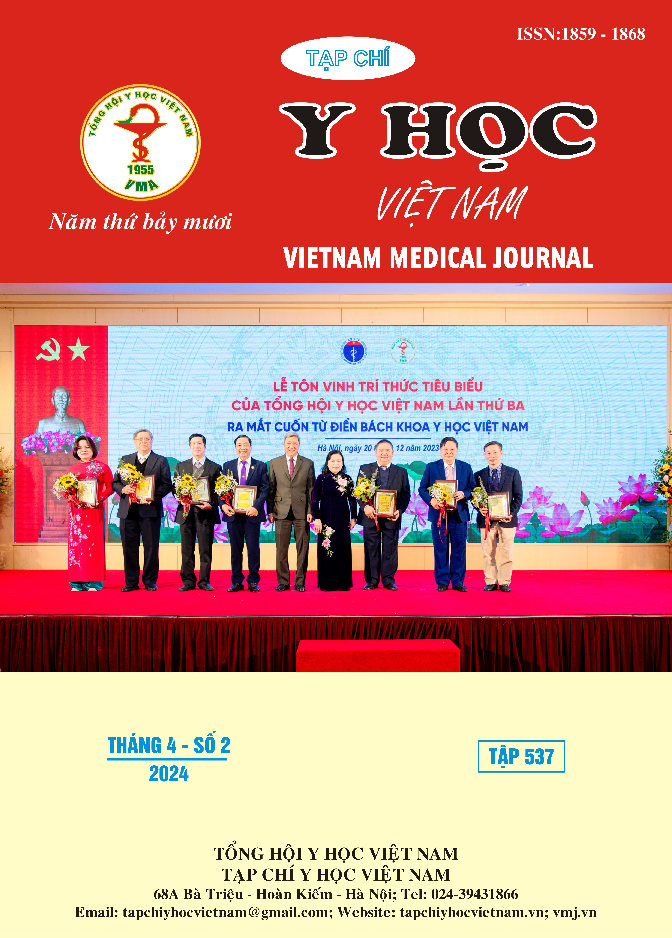MODES AND COMPLICATIONS OF CONTINUOUS RENAL REPLACEMENT THERAPY IN CHILDREN WITH DENGUE HEMORRHAGIC FEVER
Main Article Content
Abstract
Objectives: Continuous renal replacement therapy (CRRT) is a set of treatment modalities aimed at the continuous and slow removal of toxins (endogenous or exogenous), fluids and electrolytes, etc., for patients with indicated indications with or without renal failure. This study describes the prevalence of dialysis modalities, number of dialysis sessions, dialysis duration and complications associated with dialysis technique in dengue hemorrhagic fever children. Materials and methods: Descriptive 40 children with severe dengue hemorrhagic fever were continuously dialysis at the Intensive Care Unit - Anti-poisoning Department of Children's Hospital 1 and the Department of Infection of Children's Hospital 2 from January 1, 2017 to December 31, 2021. Results: Dialysis method: in our study, there were 18 cases of patients (45,0%) receiving CRRT by CVVHDF alone and 18 cases of patients (45,0%) receiving dialysis. Continuous hemodialysis by CVVHDF combined with plasma exchange. 10% of patients are dialysis by CVVH method. There were no cases of patients receiving continuous dialysis using CVVHD or a combination of 2 dialysis methods on the same patient. In our study, 2 (5,0%) cases were initiated and completed the first cycle of plasma exchange in the first 24 hours of continuous dialysis, 16 cases (40,0%) of plasma exchange. The remaining CRRT cases are started after the first 24 hours of dialysis. Specifications: The time of CRRT is mainly the 7th day of the disease, the case is started on continuous dialysis as early as the 5th day of the disease and the 14th day of the disease at the latest. Time varies from patient to patient, the earliest case ending is 25 hours and the longest is 668 hours and 15 minutes. Blood pumping rate: 4,8 ± 0,9 ml/kg/h; volume of dialysate: 29,2 ± 8,9 ml/kg/hour; replacement volume: 28,9 ± 13,8 ml/kg/hour; volume of fluid removed: 3,1 (2,1 – 4,3) ml/kg/hour; dialysis dose: 55,2 ± 14,9 ml/kg/hour. 100% of patients did not use the loading dose of Heparin anticoagulant; 32,5% of patients received maintenance dose of Heparin. Complications of CRRT: common complications in our study were membrane coagulation 57,5% and hypothermia 55,0%. Followed by patient-related complications such as thrombocytopenia 30%, hypotension 22,5%, pulmonary hemorrhage after dialysis 15,0%. There were 2 cases of patients with catheter-related sepsis when blood cultures were caused by Klebsiella and Candida spp. Conclusions: The majority of patients received continuous dialysis using CVVHDF alone or CVVHDF combined with plasma exchange. All patients were not receiving the loading dose of Heparin. The time of dialysis is usually on the 7th day of illness. Dialysis time continuously varies from patient to patient. Coagulation is the most common complication, followed by hypothermia, thrombocytopenia, and hypotension.
Article Details
Keywords
dengue hemorrhagic fever, CRRT, dialysis methods, complications of CRRT.
References
2. Nguyễn Minh Tiến, Phạm Văn Quang, Phùng Nguyễn Thế Nguyên, và cộng sự (2016), "Kết quả lọc máu liên tục trong điều trị sốc sốt xuất huyết dengue biến chứng suy đa cơ quan tại Khoa Hồi sức tích cực - chống độc Bệnh viện Nhi Đồng 1 từ năm 2004-2016", Tạp chí Y Học Thành Phố Hồ Chí Minh, 20(4),7-15.
3. Võ Thị Hồng Tiến (2020), "Lọc máu liên tục ở trẻ sốc nhiễm khuẩn tại Khoa Hồi sức tích cực chống độc Bệnh viện Nhi Đồng 2", [Luận văn tốt nghiệp bác sĩ nội trú, chuyên ngành Nhi khoa].
4. Farahnak Assadi, Fatemeh Ghane Sharbaf (2016), "Pediatric Continuous Renal Replacement Therapy", Springer,37.
5. A. Khwaja (2012), "KDIGO clinical practice guidelines for acute kidney injury", Nephron Clin Pract, 120(4),c179-84.
6. Junjing Zha, Chuan Li, Gaoxiang Cheng, Lijuan Huang, Zhaoqing Bai, Changtai Fang (2019), "The efficacy of renal replacement therapy strategies for septic-acute kidney injury: A PRISMA-compliant network meta-analysis", Medicine, 98,e15257.


